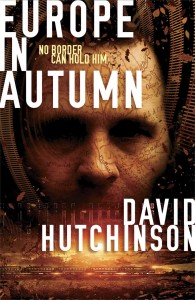 David Hutchinson’s Europe In Autumn is really three books. There’s the first half of the volume, which is an elegantly crafted spy thriller set in an all-too believable near future Europe of endless “pocket” nations. Reminiscent of early period Le Carre (you’re going to hear that comparison come up a lot in connection with this series, and with good reason), it’s a slow burn that details the transformation of the laconic Rudi, a chef in a Polish restaurant, into a high-powered member of the secret organization Coureurs des Bois.
David Hutchinson’s Europe In Autumn is really three books. There’s the first half of the volume, which is an elegantly crafted spy thriller set in an all-too believable near future Europe of endless “pocket” nations. Reminiscent of early period Le Carre (you’re going to hear that comparison come up a lot in connection with this series, and with good reason), it’s a slow burn that details the transformation of the laconic Rudi, a chef in a Polish restaurant, into a high-powered member of the secret organization Coureurs des Bois.
The Couriers may be just smugglers or they may be the ones keeping the dream of a borderless Europe alive, but either way, they’re the ones who smuggle anyone and anything imaginable across the innumerable, heavily guarded national boundaries that now stitch Europe into tiny pockets. They’re also inordinately fond of old-school tradecraft and code names, lending the Le Carre comparisons some more heft. At first Rudi seems a poor fit for the Coureur life: his mentor Fabio hangs him out to dry during an operation, and many things go wrong, badly as Rudi attempts to clear the “Situations” he’s been assigned to. But there’s a slow, steady rise of menace to Rudi’s initiation into this new world, one he approaches with as much caution and eagerness as the reader.
The second book is essentially the back third of the novel, which abruptly shifts gears. Where the reader’s introduction to Rudi is a slow burn, this is a damaged metronome, with sudden bursts of almost inexplicable action mixing it up with long, slow descriptive sequences that seem sadly flat and devoid of tension. Rudi’s a man of action here, caught up in a web of mysterious events predicated on his discovery of a severed head in a locker and his father’s political machinations. It sounds more exciting than it is, and with several sequences moving Rudi to secondary character status – including a lengthy transcription of an in-world document – the urgency and menace built by the first part of the book is largely frittered away. Rudi’s transformation is part of the problem, as the guy we saw making it out by the skin of his teeth a few short chapters ago has now acquired an impressive streak of badassery and an awful lot of high powered weaponry. The end result is an oddly disjointed feeling, one that might have the reader constantly double-checking to make sure they’re still reading the same book.
The big reveal at the end is probably what will make or break Europe in Autumn for most readers. If they understand it as a logical extension of the book’s ongoing themes concerning borders, then they’ll probably roll with it and enjoy the direction the book suddenly takes. If they feel that it’s the sudden interjection of weird, vaguely magical aspects in a way that doesn’t feel properly earned, then they’ll probably put the book down before ever reaching the end.
And then there’s the third book, which is only partially done here. Europe in Autumn is the first book in the new “Constant Coureur” series, which means that making any judgement at this point is largely impossible. Knowing that there are more books coming, it’s possible to say that it certainly sets up a sufficiently gonzo cliffhanger for book 2 to run with. On the other hand, the ending does feel rushed, bringing the reader to a somewhat uncomfortable full stop right after picking up breakneck speed.
So it’s not fair to say that I loved this book, or that I didn’t like it, because the notion of “this book” – at least as refers to this book – remains rather nebulous. Suffice to say that the first book I loved, the second book I was disappointed in, and the third book I am certainly willing to give a chance.
(Solaris, 2014)
